March 2023 News
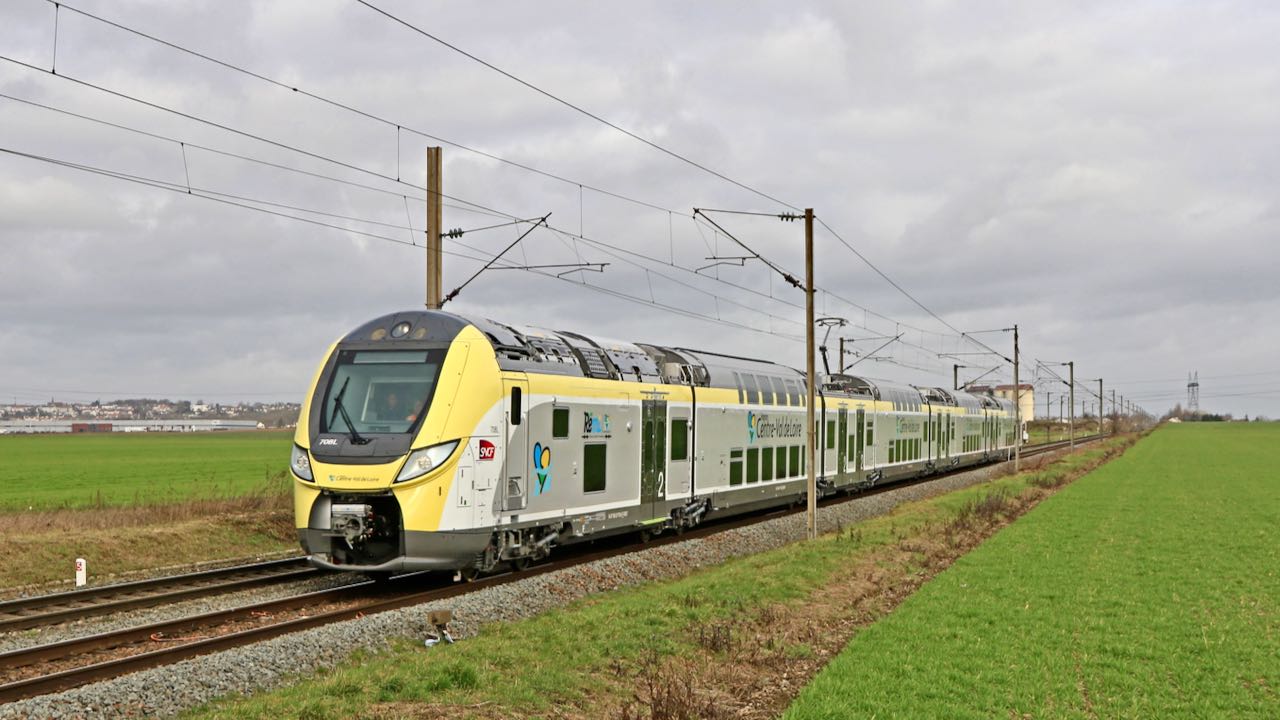
Omnio Premiums replacing Paris Corail services
On 24th January, in an event at Crespin with local dignitaries, Alstom unveiled the first of 19 ten-car XL Omneo Premiums for Hauts-de-France région. With a single-class 2+2 configuration, each unit will offer 463 seats with a high level of comfort including USB and 220 V power points and at-seat lights. These units will be for Paris Gare du Nord – Maubeuge/Cambrai services and the remaining Paris – Amiens hauled trains, replacing the existing BB 22200s and Corail stock. Costing over €250 million, funding for these trains is coming from the €400 million provided by the government for new rolling stock when Hauts-de-France took over sponsorship of Intercités services from Gare du Nord.
On the same occasion, Alstom also unveiled the first of a further 33 ten-car XL Regio 2Ns. Based on the same platform as the Omneo Premium, these will have a more intensive 2+3 seating configuration with room for two wheelchairs and 12 bicycles, and will operate outer-suburban services from Gare du Nord to Amiens and St Quentin, replacing the push-pull BB 15000s and some of the older electric stock. These units will be the first Regio 2Ns to be equipped with ERTMS to enable them operate over the new Roissy -- Picardie line north of Paris, linking Roissy/Charles-de-Gaulle airport with Amiens and Compiègne. Testing of the new signalling system will take place at Velim with delivery expected during 2024-25.
Hauts-de-France already has two fleets of Regio 2Ns delivered in 2017, consisting of 18 seven-car units operating in the Lille area and seven ten-car units operating between Gare du Nord and Amiens. Once the latest orders are complete Hauts-de-France will have a combined fleet of 77 Omneo Premiums and Regio 2Ns; they will be maintained at a purpose-built depot being constructed in the former yard at Longueau, with some work undertaken at Le Landy.

On 2nd February CFL Class 2200 No 2201 brought a splash of colour to Seine-et-Marne when it returned from a mid-life overhaul at Saint-Pierre-des-Corps Technical Centre. Based on the SNCF TER2N NG Z24500 class it is seen between La-Ferte-sous-Jarre and Nanteuil Saacy heading home to Metz and Luxembourg. The work is part of the joint OPTER programme between SNCF and CFL that will see all 23 members of the class receive interior refurbishment with new fittings and a revised livery. Photo: Christophe Masse
EU Investigation into SNCF Fret funding
The European Commission has launched an investigation into state aid and support provided to SNCF Fret to determine whether it gave it an economic advantage over its competitors and breached the European Union’s regulations on state aid. The investigation will look at three specific aspects:
- Cash payments of over €4 billion between 2007 and 2019
- Writing off €5.3 billion of debt at the end of 2019 when SNCF was restructured following legislation in 2018
- An injection of €170 million following the restructuring from January 2020
- change the Group’s structure, restoring it to its original status as a company wholly owned by the French State
- put the Group’s finances on a sound footing by transferring €35 billion in debt to the French State, thus boosting SNCF’s capacity to invest in modernizing and upgrading the rail network
- open the rail market up to competition, gradually and sector by sector
- stop recruiting under France’s special railway pension regime and negotiate a new social contract
The changes came into force on 1st January 2020. In preparation for opening up the rail market, SNCF Réseau was restructured to be entirely separate from other SNCF activities, with a separate balance sheet and directors forbidden to engage in other areas of SNCF activity. Geodis and Keolis were also separated from other SNCF activities, operating as ‘arms length’ businesses reporting direct to the main board.
From 1st January 2020, all of SNCF's railfreight interests were bought together in Rail Logistics Europe, consisting of SNCF Fret (general domestic freight), VIIA (rail motorways for semi-trailers), Naviland Cargo (maritime container traffic), Captrain (cross-border and European activities) and Forwardis (bulk flows). At times it does seem difficult to distinguish between SNCF Fret, Captrain and Forwardis activities.
The Commission has stated that interventions by public authorities in favour of companies may be considered as not constituting state aid if they are made under conditions that a market-oriented private business would have accepted. If this principle is not observed, such interventions constitute a form of state aid as specified in Article 107 of the Treaty on Functioning of the European Union, as they provide the beneficiary with an economic advantage over its competitors. The French government said it was responding to the enquiry in a co-operative and determined spirit. It pointed out that the subsidies had helped retain rail traffic and supported a range of national and EU initiatives to increase rail traffic on environmental grounds.
The guidelines for providing state aid to railway undertakings are shortly due for revision. The European Rail Freight Association (ERFA) have recently stated that direct aid to specific rail operators should be avoided, and not used to support inefficient practices. While state aid can be justified to support activities such as "last mile" and the transfer of wagonload traffic from road to rail this should be transparent and open to all operators, and avoid distorting the market for services which are viable without support,
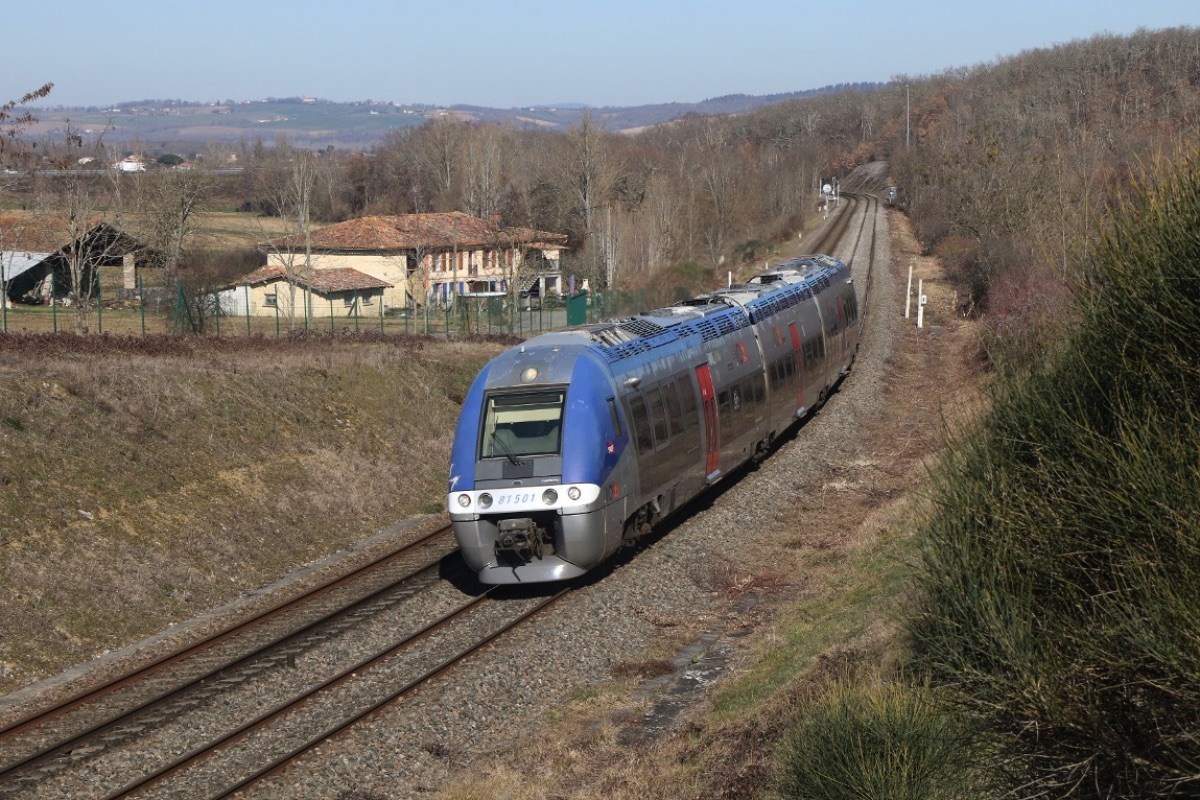
On 13th February 2023 bi-mode AGC 81501/2 between Roquesérière-Buzet and Montastruc-la-Conseillère with TER 872460/1 12:31 Mazamet – Toulouse. The doyen of the class (and the three sub-classes) B81501/2 has now been in service for over 19 years. This section of line was only converted to double track about ten years ago, including a new lengthy platform at Roquesérière-Buzet, an isolated station that sees one train a day each way. Photo: Georges Turpin
Luchon reopening a step closer
Extensive works are required to bring the line up to operational standard. The poor state of the infrastructure had led to closure in 2014, and more recently severe weather caused further degradation. On completion, a maximum speed of 90 km/h will be permitted over about half the route. Stringent environmental standards have been imposed in this area of outstanding natural features; a large number of mitigation measures will be put in place to conserve flora and fauna and to control water run-off.


For many years before closure, the line was served only by a night train from Paris and a single daily return train from Toulouse (see photos above from August 2000), mainly for tourists; buses provided the local service. Now it is planned to run six return trains daily to provide better transport options for the Comminges area and improved access to the spa town of Luchon. Provision is being made at Montréjeau for MUs to be joined and divided, suggesting that trains will reverse there and run through to Toulouse once again. At Luchon a layover siding will be provided and the runround line brought back into use for locomotive-hauled trains. Reinstatement of the overnight Paris train is a long-term aim of Occitanie région.
Restoration of the line does not include the overhead electrification equipment. This had been declared redundant despite extensive remedial work carried out not long before closure. Instead the line is to be the showcase for Occitanie’s three dual-mode electric-hydrogen MUs, part of the order for 12 trains placed with Alstom in 2021 by SNCF Voyagers on behalf of Auvergne-Rhône-Alpes, Bourgogne-Franche-Comté, Grand Est and Occitanie régions. The four-car trains are a development of the Coradia iLint family of multiple-units, the first of which went into public service in September 2022 on the Landesnahverkehrsgesellschaft Niedersachsen in Germany; they are capable of running for up to 600km on non-electrified routes. The government has provided €47 million towards the development cost; total value of the order is €190 million. The hydrogen propulsion system and drive trains are designed at Alstom’s Tarbes facility in Hautes-Pyrénées. In the event of the hydrogen MUs being unavailable when the Luchon line reopens, authorisation has been granted for diesel operation until the end of December 2025.
The first trials of hydrogen technology on the French network took place on 1st - 2nd February when a Coradia iLint hydrogen-powered two-car unit was tested between Loches and Reignac-sur-Indre on the branch from Tours. It is seen below arriving at Loches during the trial. Photo: Nouvelle République.
Originally scheduled to run for three days, the trial was prematurely terminated on the second day when the train’s speedometer failed. However, the testing had met all of its objectives and was deemed a success.
The trial was part of an initiative between Alstom and Centre-Val de Loire, which unlike the other régions is looking to buy the lighter two-car iLint variant. Ironically the test unit was towed to and from the Loire by CC 72049, one of the survivors of the class that did not have its engine replaced by a less-polluting version.


As the sun sets on the evening of 11th February BB 67586 is seen crossing the Picarel Viaduct, near Gramat, towing BB 75341 and the stock of the Rodez -- Paris overnight service. BB 75341 had failed at Rodez the previous evening, BB 67586/67621 were despatched from Brive with the Paris - Albi overnight service, upon returning to Rodez with the ECS, BB 67586 then returned to Brive with BB 75341. Photo: Christian Hospital
Occitanie rail spending up 54%
SNCF Réseau has announced investment of €483 million in Occitanie’s railways for 2023, an increase of 54 per cent over the previous year. Major infrastructure work continues at the southern end of the POLT route in readiness for introduction of the Oxygène trains (see January News), and also between Tarbes and Montréjeau. On secondary lines some 1,600km of track will receive heavy maintenance or upgrading as part of Occitanie’s plan to improve service provision and increase daily TER patronage to 100,000 by 2028.
February saw the start of preparatory works for the LGV connection with the POLT line north of Toulouse (see February News), in advance of the final environmental impact statement which is expected before the end of the year. Reconstruction and four-tracking from Toulouse to Castelnau-d’Estrétefonds (21km), where the LGV line joins the classic POLT route from Paris, will be carried out in phases through to 2031 at a cost of €500 million. These improvements will also add capacity for more frequent TER services. Such is the scale of work planned that SNCF Réseau is recruiting a further 200 engineering personnel in Occitanie.
€1 journeys: New record
Railcoop considering thrice-weekly service
Railcoop is reported to be considering operating a thrice-weekly service between Bordeaux and Lyon from summer 2024. With limited funds available to purchase and overhaul the nine former Auvergne-Rhône-Alpes TER X72500s previously identified, Railcoop is now looking to acquire three units to operate this limited service using two trains and one spare. Described as a ‘frugal start’, the service would run from Bordeaux to Lyon and return the following day. The other option previously mooted is to operate a daily return service between Bordeaux and Limoges only.
Amiens – Abancourt suspended
Subsidence at Saleux on the 3rd February has temporarily closed the Amiens – Rouen line between Amiens and Abancourt. The cause has been traced to a former chalk quarry nearby. Initially it had been hoped to reopen the line on 13th February, but it is now expected that the closure will last for several weeks while the quarry is filled in and the trackbed rebuilt. A replacement bus service was introduced from 9th February adding an hour to journeys,
Serpent de Mer arises again
At the request of the Minister of Transport, SNCF Réseau has relaunched proposals to develop a high-speed line between Paris and the Normandy Coast (LNPN), dubbed the Serpent de Mer. Increased suburban and local traffic has seen long-distance times deteriorate in recent years making rail travel along the Seine axis less attractive.
The project will look at developing dedicated lines for long-distance services avoiding those used by regional, Ile-de-France suburban and freight trains on the two sections between Paris and Mantes-la-Jolie and between Rouen and Barentin. Public consultation is taking place at the 13 municipalities along the Seine axis between January and May.
Lourdes presses for better services
The Maire of Lourdes has called for better local train services to improve accessibility in the département of Pyrénées-Atlantiques. Speaking at the annual general meeting on 3rd February of LGV-Orthez-Oui, the rail pressure group for the Béarn and Bigorre areas, Thierry Lavit echoed the group’s riposte to President Macron’s recent proposals for RERs in 10 cities: ‘what about an RER des Pyrénées?’. LOO is campaigning for upgrading of the Dax – Pau – Lourdes – Tarbes line in conjunction with construction of the Bordeaux – Dax LGV. There is strong pressure locally for reopening of stations at Lescar and Lacq, as well as improvements to the sparse TER service between Pau, Lourdes and Bayonne.
EU to support new cross-border passenger services
The European Commission has announced that it will support 10 new passenger services to improve cross-border access. Three of these involve France:
- European Sleeper, a new night train service from Amsterdam to Barcelona.
- Midnight Trains, a new night train service Paris to Milan and Venice.
- FGC (Ferrocarrils de la Generalitat de Catalunya), new cross-border services connecting Barcelona and Catalunya with Figueres, Montpellier and Toulouse.
Although no funding will be available, support will be provided to break down barriers, with the Commission and the EU Agency for Railways assisting with stakeholder co-ordination, identifying existing or upcoming support tools and clarifying compatibility with EU legislation
Brittany Ferries to introduce Cherbourg – Mouguerre service
Brittany Ferries is to introduce a rail motorway between Cherbourg and Mouguerre near Bayonne to convey semi-trailers from the UK and Ireland to southern France and the Iberian Peninsula.
Scheduled to commence in the spring of 2024, each train will consist of 21Modalohr wagons providing capacity for 42 semi-trailers. This is the third rail motorway to receive support from the Plan de France Relance, the other two being Sète – Calais and Rungis – Perpignan.
New freight terminal for Orléans
In an attempt to increase railfreight and reduce road traffic in the Orléans area the Centre-Val de Loire and Normandy regions have signed an agreement with SNCF Réseau to build a new combined freight terminal at Fleury-les-Aubrais, on the outskirts of Orléans. Costing €10.3 million the state are meeting 50% of the cost, Centre-Val de Loire 40% and Normandy 10%.
The new terminal will open in 2025 with capacity to handle 150 containers daily. The design will allow for expansion if there is sufficient demand. The former goods depot at Les Aubrais has been converted into a local SNCF Technicentre for TER units.
€60m refund for Paris commuters
Between September and December service levels on parts of the Paris Metro and RER Lines B fell below 80% due to driver shortages and industrial action. This has reduced the contracted payments due to SNCF and RATP. Île-de-France Mobilités has agreed to refund the €60 million savings to passengers. Holders of monthly (or longer) Navigo passes during this period will receive refunds of between €37.60 and €75.20
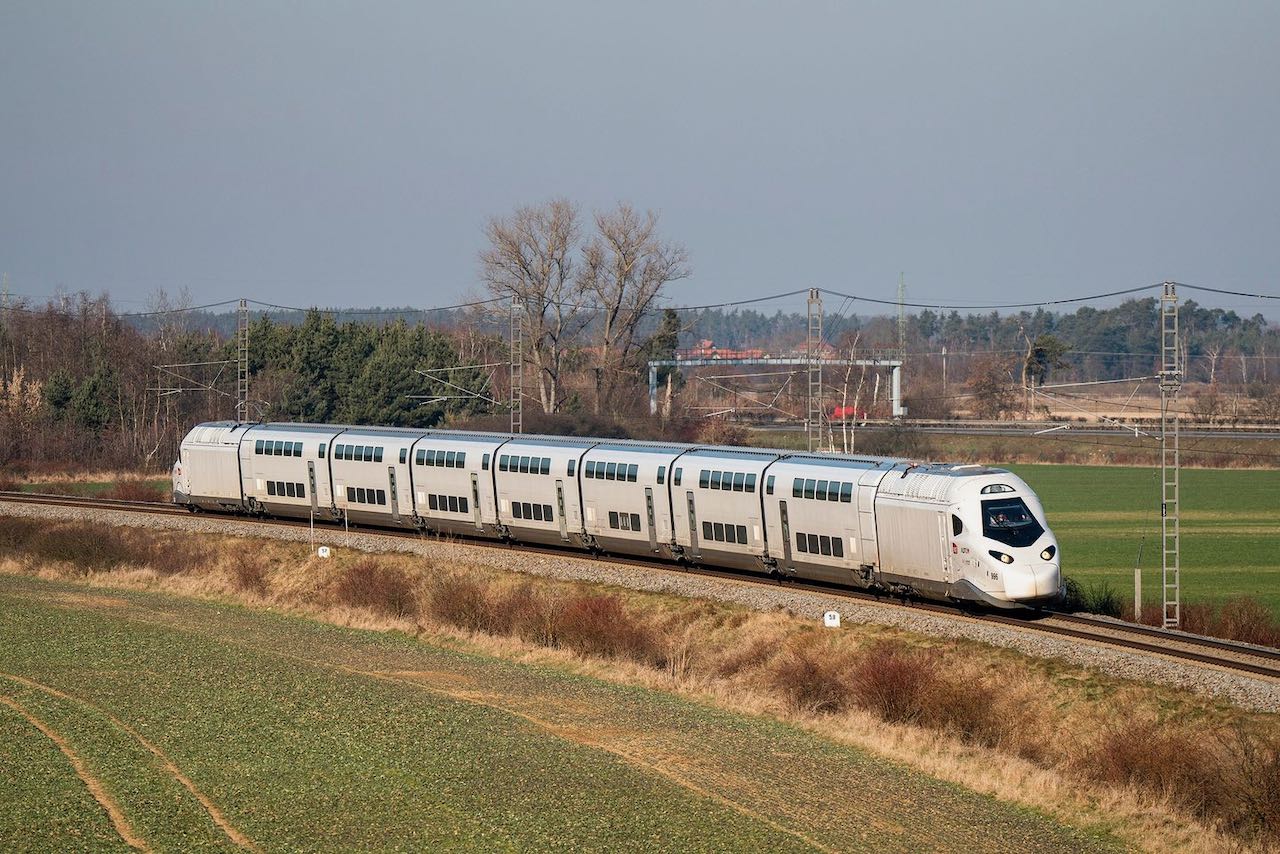
Pre-validation testing of the TGV M continues at Velim. Operating at speeds of up to 200 km/h, pre-validation tests ensure that the design meets regulatory requirements; trials are expected to last until June. The next stage will be admission tests covering meteorological and other environmental conditions that the train may face in its lifetime, with running at up to 320 km/h. A second TGV M is expected to undertake climatic testing in Vienna during March. Once this stage is completed, authorisation can be issued by the ERA (European Railways Agency), after which endurance testing will take place. The prototype trains will undergo extensive running in operational conditions to demonstrate reliability and start driver training. When these trials are completed, the prototype trains will have run over a million kilometres. Photo: Alstom
Eurostar Group unveils new branding
January 24th saw Eurostar Group unveil its new branding following the merger with Thalys last year. The new logo is based upon the Etoile du Nord, the name of the original rail service linking Paris, Brussels and Amsterdam. With a combined fleet of 51 trains (25 Eurostar, 26 Thalys), Eurostar says it is ‘the biggest high speed network in Europe, connecting five countries and 245 million people’. Under a single brand, Eurostar intends to offer an attractive alternative to European road and air travel, particularly with air travel between London and Amsterdam having a carbon footprint seven times larger.
Having carried 14.8 million passengers in 2022, Eurostar's aim is to increase to 30 million passengers annually by 2030. From October 2023 the former Thalys and Eurostar websites and booking systems will be merged, making it possible to book between any two destinations on the two former networks in a single transaction. The two loyalty programmes will also merge.
Under the EU Commission proposals outlined above to increase cross-border travel, NS is seeking enhancement of the existing Amsterdam – London service in co-operation with Eurostar, although it is unclear what format this will take.


While Eurostar's ambitions sound laudable, the current reality is different on services to and from the UK. Boarding conditions post-Brexit that require British passports to be stamped limit passenger capacity at Eurostar terminals, in part due to insufficient border staff. As a result, trains to and from the UK are only booked to two-thirds of capacity and Eurostar is only running 14 trains a day to and from London compared to 18 in 2019. These problems have also seen the service to Disneyland halted and trains no longer calling at Ebbsfleet and Ashford International.
The EU’s Entry/Exit System (EES) will replace manual checking, but the technology has been delayed several times and is now due to be implemented at the end of 2023. There are concerns that the initial registration will cause delay as people entering the bloc from the UK will need to register fingerprints and a photo with their passport details. They will then have to re-register every three years.
The EU’s Entry/Exit System (EES) will replace manual checking, but the technology has been delayed several times and is now due to be implemented at the end of 2023. There are concerns that the initial registration will cause delay as people entering the bloc from the UK will need to register fingerprints and a photo with their passport details. They will then have to re-register every three years.
Eurostar’s ski train resumed on 16th December as the Travelski Express, a charter train financed by Compagnie des Alps, operator of many of the French Alpine ski resorts. Travel is only available as part of a holiday package with accommodation and transfers booked through Travelski. The train runs outward from St Pancras International on Friday nights until 7th April at varying times after 19.00, returning on Saturdays until 15th April as a day train departing Bourg-St-Maurice at 09.31 to St Pancras for a 16.00 arrival. On 18th February Set 4022 rolls into Moutiers for departure at 10.18 timetabled non-stop to London but with crew change at Lille Europe. Photo: Jo-Anne Purchase
SNCF and SBB/CFF renew partnership agreement for next five years
SNCF and SBB/CFF have renewed their partnership agreement until the end of 2027. The agreement which has already existed for over 40 years forms the basis for development of the rail market between France and Switzerland and provision of high-speed services by Lyria, of which 76 per cent is owned by SNCF and 24 per cent by SBB/CFF.
Lyria has a fleet of 15 refurbished duplex TGVs each offering 507 seats. Seventeen return services operate daily on three-high speed routes; eight between Paris and Genève, six between Paris and Lausanne, including three via the Jura, and six between Paris and Basel/Zürich. In summer, a fourth daily service connects Genève to Marseille. Lyria services still provide a reasonable level of comfort with free internet, a bar car, and at seat dining in Business Première class.
In 2022 Lyria carried five million passengers with traffic returning to 2019 pre-Covid levels
In 2022 Lyria carried five million passengers with traffic returning to 2019 pre-Covid levels

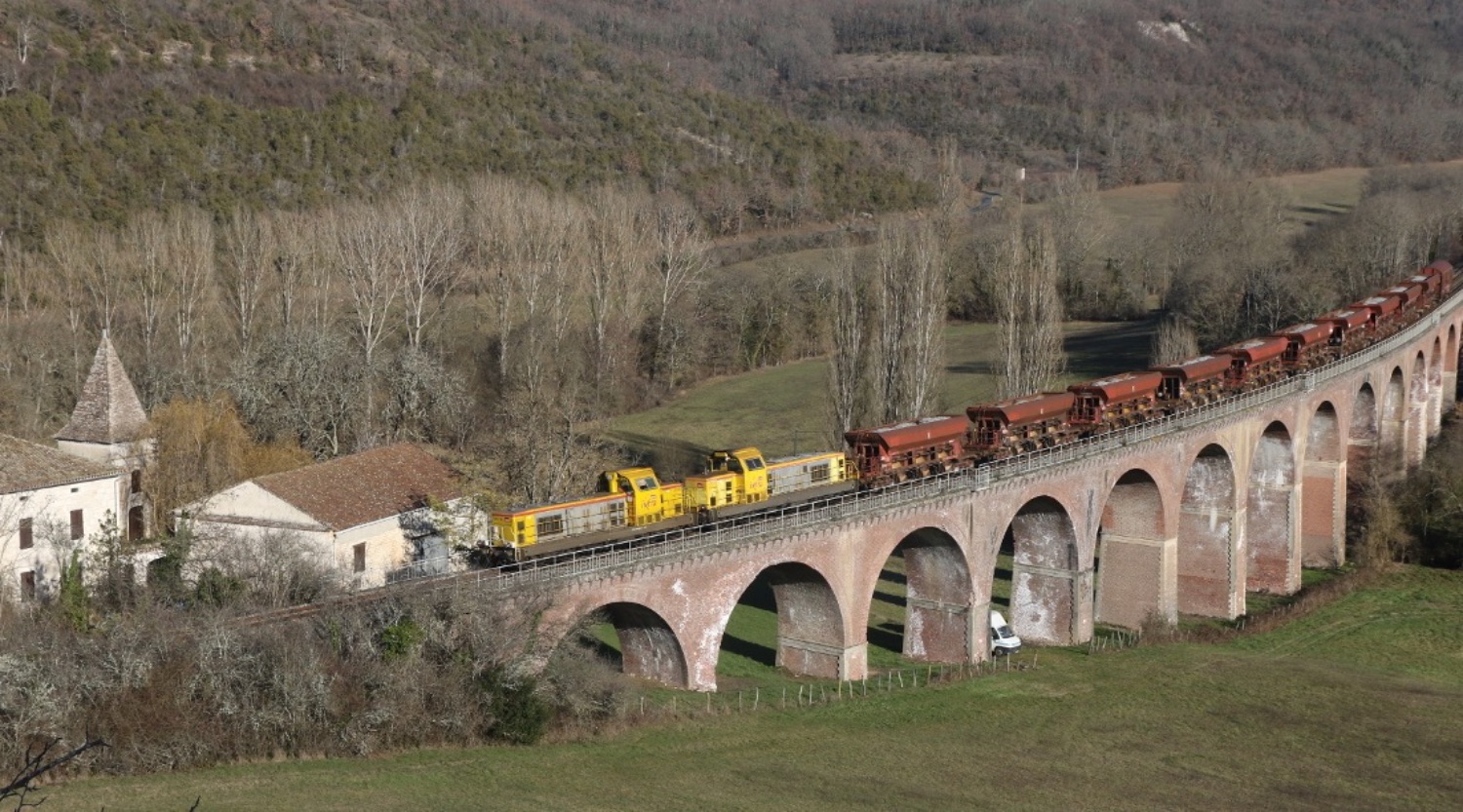
A pair of Infra BB 69000s cross the viaduc de la Tour at Amarens between Donnazac and Cordes-Vindrac with a ballast train from Saint-Jory to Capdenac on Monday 13th February. Since the fire at Figeac in November 2018 through trains only pass through Figeac and Capdenac on the Brive -- Rodez axis. Services between Toulouse , Aurillac and Clermont Ferrand continue to terminate at Capdenac or Figeac with a bus connection between the two. Photo: Georges Turpin.
Work starts on Toulouse Metro line 3
Work has started on construction of Toulouse's third metro line with sinking of a 30-metre shaft at Sept Deniers. Originally to be called Aerospace Express, it will now be plain Line C, a 27km fully-automated line with 21 stations from Colomiers via Blagnac (for tram connection to airport), passing the Airbus plant, to Matabiau and continuing south-eastwards to Labège; 22km of the line and 17 stations will be underground, the remainder elevated with interchanges to Lines A & B at five locations.
Total cost is budgeted at €3.4 billion to be funded by operator Tisséo, the State, Occitanie région, the département of Haute-Garonne, and the EU. This figure also covers a two-station extension of Line B from Ramonville to Institut National Polytechnique de Toulouse, and a new stop at Jean Maga on tram routes T1 and T2 which will provide interchange with Line C.
The first contract has been awarded for the 8.4km section from Airbus St Martin to Raynal, valued at €589 million. Construction is scheduled to be completed by 2027, with the line opening in 2028.
A full-size model was on display at Capitole from 26th January to the 9th February.
They will be air-conditioned and fitted with LED lighting that adjusts to travel conditions, reinforced air filtration and antibacterial coatings on the handrails. Each car will have three 1.5m doors each side to avoid lengthy dwell time at stops.

Turning back the clock
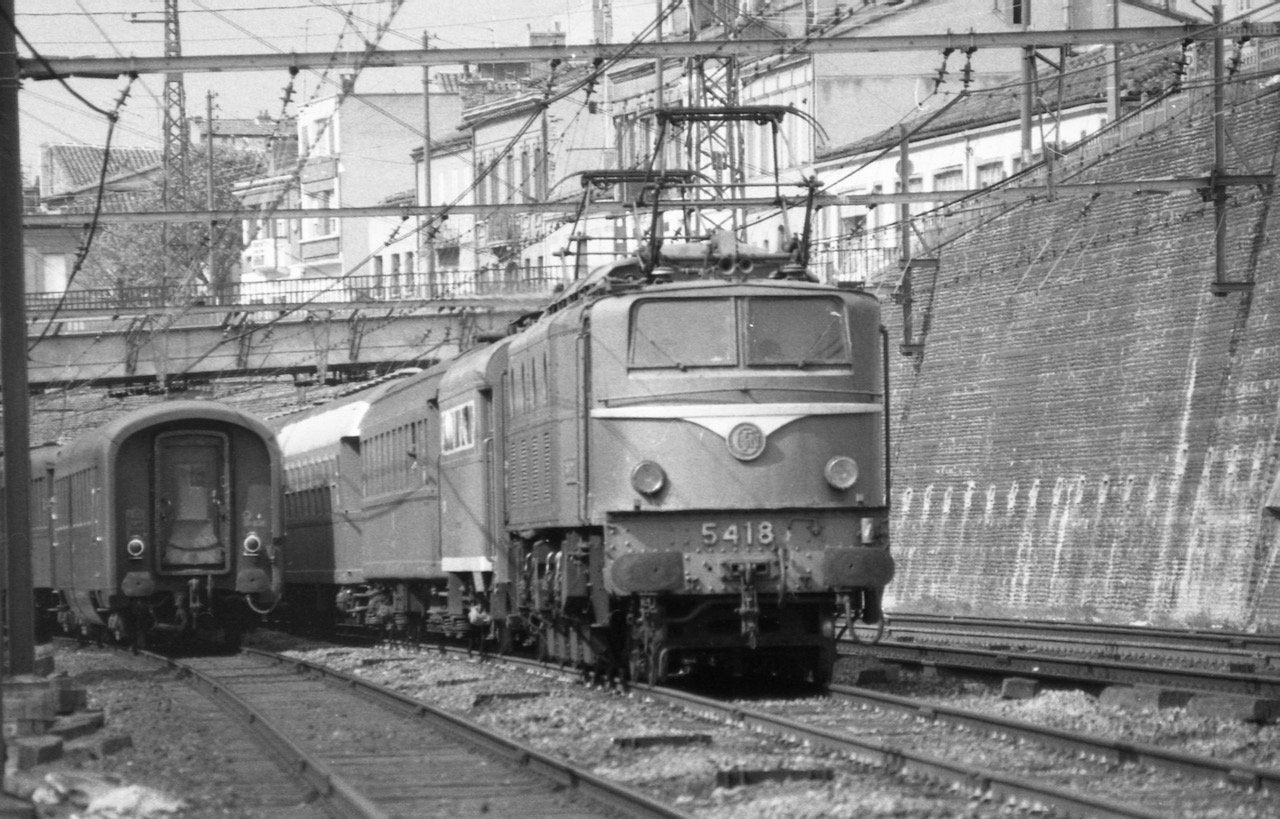
In November News we showed some photos of Le Train historique de Toulouse's BB 7200s operating with a boiler van to heat their steam-era coaches. The photo above shows the combination of electric traction and steam heat in normal service with 2D2 5418 leaving Toulouse in April 1979. The boiler van has been attached to a train of Italian pilgrims heading to Lourdes; at this time, some older FS stock including ambulance coaches had not been fitted with electric heating. Class 2D2 5400s were not common in the Toulouse area; 2D2 5418 was introduced by the Etat in 1937 and was one of the last two examples to be withdrawn in December 1980. Photo Georges Turpin
CFBS - Noyelles track layout developments
CFBS has completed the first stage of a major expansion and improvement of the track layout at Noyelles-sur-Mer where the Baie de Somme network connects with SNCF’s main line from Amiens to Calais. The layout dated from the mid-1980s when CFBS was carrying 50,000 passengers a year; by 2022 this had increased to 214,000 accommodated in longer and heavier trains. There are now also lunchtime and evening dining trains, and at peak times reliefs that require complex manoeuvring due to the constrained layout. A particular issue has been the closeness of the two main platform lines at the scissors crossover end making it difficult to load and unload cycles and prams from the fourgons, especially when another train is running in.
The three diagrams below show the previous layout, the current layout following work undertaken this winter, and the planned further developments. The standard-gauge tracks (including the main line) are shown in green, metre-gauge in black and dual-gauge a mix of the two.
Opposite is the layout that existed until December 2022. The two main platform lines run to the left of the scissors crossover and are very close together, making access to the fourgons difficult, with only one train able to move at a time. Above these two lines is the locomotive runround loop. Further above is a former dual-gauge raised siding connected to the station layout about six years ago. This will accommodate a short train or autorail, but it joins the main line at the divergence of the Le Crotoy and St-Valery lines and requires the pointwork to be locked when not attended.
The proposed future development. The short standard-gauge headhunt (capable of taking little more than a two-car autorail) will be slewed over slightly and extended into a dual-gauge line running parallel with the SNCF down platform, allowing longer standard-gauge trains to visit St-Valery. The long siding at the top of the layout that runs past the former grain warehouse, now used to store CFBS stock, will be extended and linked to the station network, thus increasing flexibility.
Diagrams: Maurice Testu



Forthcoming Railtours

Autorails de Bourgogne Franche-Comté (ABFC) still has seats available for its 25th March tour Balade dans le Morvan in the association’s preserved Picasso autorail No X4039. Departing Dijon at 08.15, the route covers: Tonnerre, Laroche-Migennes, Auxerre, Cravant-Bazarnes, the branch to Avallon, Clamecy and Corbigny. Tickets for non-members are €82, booking at: https://www.autorails-abfc.fr/evenements.
The two-day tour Le Picasso et les Alpes on 22nd – 23rd April running from Dijon to Grenoble and Veynes is fully booked. Further details are awaited of events on the Journées Européennes du Patrimoine (16th and 17th September) and the Léman Express railtour (23rd and 24th September).



© Peter Lovell & Chris Bushell. The French Railways Society 2023. With thanks to Georges Turpin, Christophe Masse, Jo-Anne Purchase, Maurice Testu and Christian Hospital.
